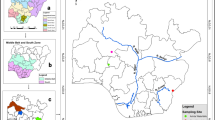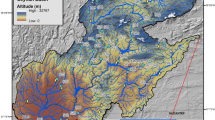Abstract
The aim of this paper was to investigate the potential for using functional feeding groups (FFGs) as indicators of water quality conditions in rivers, using the Buffalo River, South Africa, as a specific example. Multivariate classification and ordination techniques were used to investigate species and FFG distributions in relation to a number of physico-chemical variables at 16 sites from the headwaters to the estuary of the Buffalo River.
Two-way indicator species analysis (TWINSPAN) of species composition ranked most of the sites sequentially down the river, irrespective of water quality conditions. Ordination of FFGs from a set of riffle samples collected in mid-late summer showed only weak relationships between FFG distribution and water quality changes, except where variables changed sequentially down the river (e.g. pH and temperature). Individual species responses to water quality gradients were examined for nine riffle-dwelling species representing diverse FFGs. Following correspondence analysis of a matrix of environmental variables and species frequencies, some species showed strong associations with defined ranges of some variables. In particular, Adenophlebia auriculata (Leptophlebiidae, Ephemeroptera) from the headwater sampling site, was associated with low pH and low temperature. Simulium damnosum occurred under conditions of high turbidity, while Afronurus harrisoni was found under high concentrations of potassium, ammonium and nitrite ions.
We conclude that although there was a distinct headwaters fauna in the Buffalo River, and sequential downstream changes in species composition, most FFGs (apart from shredders) were represented down the whole length of the river. FFG classifications are therefore unlikely to provide useful indications of water quality conditions in the Buffalo River.
Using a categorical approach to classifying water quality variables, and by applying correspondence analysis to the resulting matrix, we recognised nine species that could be used to define water quality. These indicator species can be used to define tolerance ranges of the fauna for water quality conditions in different parts of the Buffalo river.
Similar content being viewed by others
References
Balon, E. K., 1975a. Reproductive guilds of fishes: a proposal and definition. J. Fish. Res. Bd Can. 32: 821–864.
Balon, E. K., 1975b. Ecological guilds of fishes: a short summary of the concept and its application. Verh. int. Ver. theor. angew. Limnol. 19: 2430–2439.
Bruton, M. N. & G. S. Merron, 1990. The proportion of different eco-ethological sections of reproductive guilds of fishes in some African inland waters. Envir. Biol. Fishes 28: 179–187.
Chutter, F. M., 1994. The rapid biological assessment of stream and river water quality by means of the macroinvertebrate community in South Africa. In: Vijs, M. C. (ed.), Classification of rivers, and environmental health indicators. Proceedings of a joint South African/Australian workshop. February 7–14, 1994, Cape Town, South Africa. Water Research Commission Report No. TT 63/94.
Corkum, L. D. & J. J. H. Ciborowski, 1988. Use of alternative classifications in studying broad scale distributional patterns of lotic invertebrates. J. N. am. Benthol. Soc. 7: 167–179.
Cummins, K. W., 1973. Trophic relations of aquatic insects. Annu. Revue. Ent. 18: 183–206.
Cummins, K. W., 1974. Structure and function of stream ecosystems. BioScience 24: 631–641.
Currie, D. C. & D. A. Craig, 1987. Feeding strategies of larval black flies. In K. C. Kim & R. W. Merritt (eds), Blackflies. Ecology, population management and annotated world list, University Park & London, Pennsylvania State University Press.
Dahl, C., L. E. Widahl & C. Nilsson, 1988. Functional analysis of the suspension feeding system in mosquitoes (Diptera: Culicidae). Ann. ent. Soc. Am. 81: 105–127.
Department of Water Affairs and Forestry, 1991. Water quality management policies and strategies in the RSA. Department Water Affairs and Forestry, Pretoria, 38 pp.
Department of Water Affairs and Forestry, 1992. Water for managing the natural environment. Report no. DFR-ENVIRO-POLICY-00192, Pretoria, 21 pp.
Dixit, S. S., A. S. Dixit & J. P. Smol, 1989. Relationship between chrysophyte assemblages and environmental variables in seventy-two Sudbury lakes as examined by Canonical Correspondence Analysis (CCA). Can. J. Fish. aquat. Sci. 46: 1667–1676.
Faith, D. P., 1990. Benthic macroinvertebrate in biological surveillance: Monte Carlo significance tests on functional group's response to environmental gradients. Envir. Monit. Assess. 14: 247–264.
Furse, M. T., D. Moss, J. F. Wright & P. Armitage, 1984. The influence of seasonal and taxonomic factors on the ordination and classification of running water sites in Great Britain, and on the prediction of their macroinvertebrate communities. Freshwat. Biol. 14: 257–280.
Hawkins, C. P. & J. A. MacMahon, 1989. Guilds: the multiple meanings of a concept. Annu. Revue Ent. 34: 423–451.
Hill, M. O., 1979. TWINSPAN — A Fortran program for arranging multivariate data in an ordered two-way table by classification of the individuals and attributes. Unpublished report, Ecology and Systematics, Cornell University, Ithaca.
Karr, J. R., 1991. Biological integrity: A long-neglected aspect of water resource management. Ecol. Appl. 1: 66–84.
King, J. M., J. A. Day, P. R. Hurly, M-P. Henshall-Howard & B. R. Davies, 1988. Macroinvertebrate communities and environment in a southern African mountain stream. Can. J. Fish. aquat. Sci. 45: 2168–2181.
Mackay, R. J. & K. E. Kersey, 1985. A preliminary study of the aquatic communities and leaf decomposition in acid streams near Dorset, Ontario. Hydrobiologia 122: 3–11.
McShaffrey, D. & W. P. McCafferty, 1988. Feeding behaviour of Rilhrogena pellucida (Ephemeroptera: Heptageniidae). J. N. am. Benthol. Soc. 7: 87–99.
Merritt, R. W. & K. W. Cummins (eds), 1984. An introduction to the aquatic insects of North America. Kendall/Hunt, Dubuque, Iowa.
Metcalfe-Smith, J. L.,1991. Rivers Handbook, Volume 2. Chapter 3: Monitoring Programmes. Section 3.3: Biological water quality assessment of rivers based on macroinvertgrate communities. NWRI Contribution No. 91–71. 58 pp.
Palmer, C. G. & J. H. O'Keeffe, 1992. Feeding patterns of four macroinvertebrate taxa in the headwaters of the Buffalo River, eastern Cape. Hydrobiologia 228: 157–173.
Palmer, C. G, J. H. O'Keeffe & A. R. Palmer 1991. Macroinvertebrate habitat relationships in the Buffalo River, South Africa. J. N. am. Benthol. Soc. 10: 349–357.
Palmer, C. G, J. H. O'Keeffe, J.H. & A. R. Palmer, 1993a. Macroinvertebrate functional feeding groups in the middle and lower reaches of the Buffalo River, eastern Cape, South Africa. 2. Functional morphology and behaviour. Freshwat. Biol. 29: 455–462.
Palmer, C. G, J. H. O'Keeffe, A. R. Palmer, T. Dunne & S. Radloff, 1993b. Macroinvertebrate functional feeding groups in the middle and lower reaches of the Buffalo River, eastern Cape, South Africa. 1. Dietary variability. Freshwat. Biol. 29: 441–453.
Palmer, R. W., 1991. Downstream effects of impoundments in the Buffalo River, eastern Cape, with particular reference to the taxonomy and distribution of the blackfly (Diptera: Simuliidae) of southern Africa. Ph. D. Thesis, Rhodes University, Grahamstown.
Palmer, R. W. & J. H. O'Keeffe, 1989. Temperature characteristics of an impounded river. Arch. Hydrobiol. 116: 471–485.
Palmer, R. W. & J. H. O'Keeffe, 1990. Downstream effects on the water chemistry of the Buffalo River (eastern Cape), South Africa. Hydrobiologia 202: 71–83.
Raunkaier, C., 1934. The life forms of plants and statistical plant geography. Clarendon Press, Oxford.
Root, R. B., 1967. The niche exploitation pattern of the bluegray gnatcatcher. Ecol. Monogr. 37: 317–350.
Shipley, B., P. A. Keddy, D. R. J. Moore & K. Lemky, 1989. Regeneration and establishment strategies of emergent macrophytes. J. Ecol. 77: 1093–1110.
Simberloff, D. & T. Dayan, 1991. The guild concept and the structure of ecological communities. Annu. Revue Ecol. Syst. 22: 115–143.
Sprules, W. G., 1984. Towards an optimal classification of zooplankton for lake ecosystem studies. Verh. int. Verein. theor. angew. Limnol. 22: 320–325.
Ter Braak, C. J. F., 1987. The analysis of vegetation-environment relationships by canonical correspondence analysis. Vegetatio 69: 69–77.
Ter Braak, C. J. F., 1988. Canoco — a FORTRAN program for canonical community ordination by (partial) (detrended) (canonical) correspondence analysis, principal component analysis and redundancy analysis (version 2.1). Technical report LWA-88–02, Postbus 100, Wageningen, 1–95.
Townsend, C. R., A. G. Hildrew & J. Francis, 1983. Community structure in some southern English streams: the influence of physicochemical factors. Freshwat. Biol. 13: 521–544.
Van der Merwe, W. & D. C. Grobler, 1990. Water quality management in the RSA: preparing for the future. Water SA 16: 49–54.
Vannote, R. L., G. W. Minshall, K. W. Cummins, J. R. Sedell & C. E. Cushing, 1980. The River Continuum Concept. Can. J. Fish. aquat. Sci. 37: 130–137.
Winterbourn, M. J. & K. J. Collier, 1987. Distribution of benthic invertebrates in acid, brown water streams in the South Island of New Zealand. Hydrobiologia 153: 277–286.
Author information
Authors and Affiliations
Rights and permissions
About this article
Cite this article
Palmer, C.G., Maart, B., Palmer, A.R. et al. An assessment of macroinvertebrate functional feeding groups as water quality indicators in the Buffalo River, eastern Cape Province, South Africa. Hydrobiologia 318, 153–164 (1996). https://doi.org/10.1007/BF00016677
Received:
Revised:
Accepted:
Issue Date:
DOI: https://doi.org/10.1007/BF00016677




